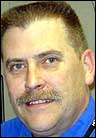Two years after designing and installing a tool-tracking system for use at its Irving, Texas, location, heavy equipment company Holt Cat, together with Irving-based RFID technology provider SAVR Communications, is marketing the system to Caterpillar equipment retailers, as well as to other companies that need to track tools as they are used by personnel.
Holt Cat operates 16 facilities in eastern and central Texas that repair heavy industrial equipment, earth movers and tractors. Managing the tens of thousands of tools in all of those facilities previously cost the company, on average, $10,000 a month per site, estimates Mark Pavuk, the company’s service assets supervisor, just in lost man-hours when tools were misplaced. There were several causes for the lost man-hours, he says. In some cases, employees spent hours on the job searching for tools, or simply didn’t get a task completed because the necessary tools were missing. In other cases, during night shifts, workers were unable to use the tools at all because the tool storage room was kept locked at times when no staff member was manning the room.
Seeking a way to solve this problem at its Irving location, Holt Cat tried using bar-coding, in conjunction with AccuTRACKER software provided by a Columbus, Ohio, firm called Software Sales and Marketing, and asked its staff to scan the bar–coded label on each item taken from the room. However, Pavuk says, employees indicated that this system was not working. “They just wanted a hands-free, no-sweat system,” he states.
Holt Cat then replaced the bar-code labels with 915 MHz EPC Gen 2 passive RFID tags, making it possible for employees to enter and exit the tool room with any tools they require. Meanwhile, RFID interrogators at the doors captured the ID numbers of workers, as well as of the tools they removed and returned, thereby allowing the company to track who has which tools at any particular time (see RFID Helps Holt Cat Keep Tabs on Tools).
The combination of AccuTRACKER and radio frequency identification proved so successful, Pavuk says, that Holt Cat installed the RFID-based solution at its San Antonio facility six months after completing the Irving installation. The system is also being installed at another eight Holt Cat facilities, he adds, and is expected to become fully operational by April 2009. By December 2009, a total of 12 of the company’s 16 facilities should have the system up and running.
But in the meantime, Pavuk notes, Holt Cat has discovered that the need for tool tracking is not limited to its own firm. Following the death of Software Sales and Marketing’s president, Steve Martin, Holt Cat decided to purchase the operation and begin marketing the complete solution with SAVR. In early November, Holt Cat installed a system at one of its dealers located outside of Texas. Holt Cat provides AccuTRACKER, as well installation and technical support services, while SAVR provides various makes and models of RFID interrogators, antennas and tags, as well as R-Box middleware, which integrates the stream of RFID read data with AccuTRACKER.
This dealer, like most companies with a large tool inventory, had employed a staff member to manage its tool room and track the movements of tools into and out of that room. The dealer’s staff utilized a paper-and-pen-based system in which an employee manually wrote down his or her name and the serial numbers of the tools being taken, after which the tool room manager keyed that data into the company’s back-end system, to be tracked on an Excel spreadsheet.With the AccuTRACKER solution from Holt Cat and SAVR, the dealer has an automatic view into which worker is using which particular tool, and for how long.
Staff members carry ID cards in their back pockets. Each contains a passive high-frequency (HF) 13.56 MHz RFID tag that complies with the ISO 15693 standard and is encoded with a unique identification number. As an employee enters the portal, Feig Electronic reader antennas capture that individual’s ID number, while Sirit ultrahigh-frequency (UHF) readers and antennas capture the ID numbers encoded to the Gen 2 tags attached to each tool that employee may be returning.
Several different kinds of UHF tags are placed on tools, which vary from drill pits and wrenches to floor sweepers and 50-ton presses. Conversely, when a technician leaves the tool room with tools, the UHF tags—which have a 2-foot read range—are interrogated along with the RFID badge’s HF tag, associating that employee with those tools in the system.
By using UHF tags for tools and HF tags for staff IDs, Pavuk says, the system is able to easily differentiate between the two. This makes it easier for an employee’s ID to be isolated from a tool’s ID number.
According to Pavuk, it cost Holt Cat approximately $70,000 to install the system at one facility, so with $10,000 wasted in man-hours searching for tools each month, he calculates his company saw a return on investment within seven months, based on that cost alone. The system also provides greater security, however, since tools are less likely to simply walk away.
In addition, because the AccuTRACKER software system is integrated with Holt Cat’s central ERP system, it can be accessed company-wide. In that way, different facilities can share tools and track their movements and locations, thereby providing the firm with insight into how often specific, more expensive tools are utilized, and in which facilities—information it can then utilize to make purchasing decisions.
Marketing the system, Pavuk estimates, will earn Holt Cat approximately $1 million in sales in 2009, and more than that amount in 2010. Holt Cat is currently in discussions with other potential customers, he says, such as mining and construction companies.


